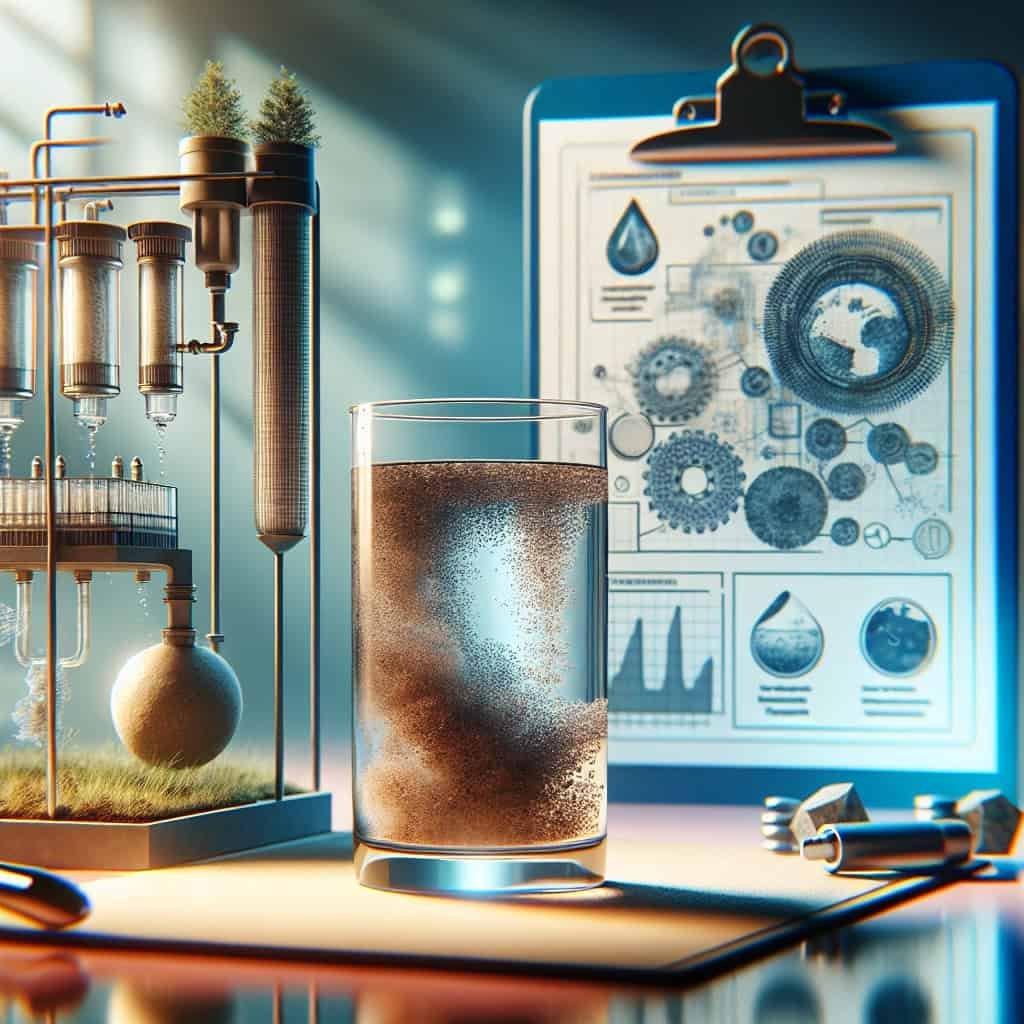Dealing with well water that has high turbidity can be a frustrating challenge for homeowners. The presence of suspended particles and sediment in the water can not only affect its appearance but also compromise its quality. However, fear not! In this article, we will explore some effective techniques and solutions to help you effectively handle well water with high turbidity. Whether you’re looking for quick fixes or long-term solutions, we’ve got you covered. So, let’s dive in and discover how to tackle this turbidity trouble head-on!
Identifying the Causes of High Turbidity
Understanding the Nature of Well Water Turbidity
Turbidity refers to the cloudiness or haziness of water caused by suspended particles, such as sediment, algae, and organic matter. In the case of well water, turbidity can occur due to various factors. It is essential to understand the nature of well water turbidity to effectively address the issue.
Well water is often susceptible to turbidity because it is sourced from underground aquifers. These aquifers can contain sediment and other particles that get disturbed during the pumping process. Additionally, activities near the well, such as construction, runoff from agricultural fields, or natural events like heavy rainfall, can introduce turbidity-causing particles into the water.
Common Sources of Turbidity in Well Water
To identify the causes of high turbidity in your well water, it is crucial to consider various potential sources. Sediments, such as sand, silt, clay, and other fine particles, are one of the primary sources of turbidity in well water. These sediments can enter the well through cracks or improper construction, or they may already exist in the aquifer.
Algae growth can also contribute to turbidity in well water. Algae blooms occur when there is an abundance of sunlight, nutrients, and stagnant water. Algae particles can easily enter the well system, especially if it lacks proper protection or if there are breaches in the well casing.
Furthermore, organic matter, such as decaying leaves or vegetation, can find its way into the well water, leading to increased turbidity levels. Contamination from nearby septic systems or agricultural activities can introduce organic matter and bacteria, further exacerbating turbidity issues.
Testing the Water to Confirm High Turbidity
To confirm and quantify the turbidity levels in your well water, it is essential to conduct water testing. Turbidity testing measures the amount of suspended particles in the water and provides a numerical value known as nephelometric turbidity units (NTU). Testing the water will not only confirm the presence of high turbidity but also assist in determining the most appropriate treatment method.
Water testing can be performed using turbidity meters, which employ light scattering techniques to assess the amount of suspended particles. In some cases, a laboratory analysis may be required to obtain accurate results. It is advisable to consult a water testing professional to ensure reliable and precise measurements.
Potential Health Risks Associated with High Turbidity
The Impact of Turbidity on Drinking Water Quality
High turbidity in well water can have detrimental effects on its overall quality. Turbid water may appear unappealing and aesthetically displeasing, but more importantly, it can also indicate the presence of other harmful contaminants. Turbidity can act as a carrier for bacteria, viruses, and other pathogens, impacting drinking water safety.
Turbidity interferes with disinfection processes, reducing the effectiveness of common disinfectants like chlorine or ultraviolet (UV) light. When turbidity is high, it can shield microorganisms from the disinfectant, allowing them to survive and potentially cause illnesses.
Health Issues Linked to Consuming Turbid Water
Consuming well water with high turbidity can lead to several health issues. Pathogens present in turbid water can cause gastrointestinal illnesses, such as diarrhea, nausea, and vomiting. These can be especially severe for individuals with weakened immune systems, young children, or the elderly.
Turbid water can also impact the taste and odor of drinking water, making it unpalatable for consumption. This can lead to a decreased desire for drinking water, potentially leading to dehydration and other related health concerns.
Importance of Addressing Turbidity Concerns
Addressing turbidity concerns in well water is essential to ensure the safety and quality of the water supply. By identifying and treating the causes of high turbidity, you can protect yourself and your family from potential health risks associated with consuming contaminated water. Implementing appropriate treatment methods and regularly monitoring turbidity levels will help maintain a reliable and healthy water source.

Measuring Turbidity Levels
Understanding Turbidity Measurements
Turbidity measurements quantify the level of cloudiness or haziness in water caused by suspended particles. The unit of measurement most commonly used is nephelometric turbidity units (NTU). NTU values indicate the scattering of light by particulate matter in the water sample.
Low turbidity levels (less than 1 NTU) are usually associated with crystal-clear water, while higher values indicate increased cloudiness or haziness. It is important to note that turbidity levels are not an exact measure of specific contaminants. However, they serve as a general indicator of water quality and can help identify potential issues.
Methods and Devices for Measuring Turbidity
Several methods and devices are available for measuring turbidity levels in well water. One commonly used device is a turbidity meter, also known as a turbidimeter. Turbidity meters utilize light scattering to measure the amount of suspended particles in the water.
Another method involves comparing the clarity of the water sample against a standard known as a turbidity tube. The turbidity tube consists of a clear tube filled with water to which a known amount of suspended particles is added. By visually comparing the sample to the standard, an estimate of turbidity can be made.
For accurate and reliable results, it is recommended to consult a professional water testing laboratory or a certified water treatment specialist. They can provide precise measurements and guidance on interpreting the results.
Interpreting Turbidity Results
Interpreting turbidity results involves assessing the numerical value obtained from the measurement and understanding its implications. As mentioned earlier, low turbidity values (less than 1 NTU) generally indicate clear water, while higher values suggest increased cloudiness.
When interpreting turbidity results, it is important to consider the specific water source and its intended use. For example, public water supplies typically have strict turbidity regulations, and any levels exceeding those standards may require immediate attention. In contrast, private well water turbidity standards may vary depending on local guidelines and personal preferences.
It is crucial to consult with water treatment professionals or local health authorities to determine the turbidity thresholds that are appropriate for your specific situation. They can provide further guidance on the necessary treatment methods or filtration systems to ensure safe and clean water.
Implementing Pre-Filtration Methods
Introduction to Pre-Filtration
Pre-filtration refers to the process of removing larger particles and sediments from well water before it undergoes further treatment. This step is particularly important in addressing turbidity concerns, as it helps alleviate the strain on subsequent treatment systems and prolong their lifespan.
The primary purpose of pre-filtration is to trap and remove visible particles that contribute to turbidity. By eliminating these larger contaminants early in the treatment process, the efficiency of subsequent treatment methods, such as filtration or disinfection, can be greatly improved.
Choosing the Right Pre-Filtration System
When selecting a pre-filtration system, consider the specific characteristics of your well water, including the level of turbidity and the size and type of particles present. Depending on the water quality, various pre-filtration options are available, such as sediment filters, cartridge filters, or multimedia filters.
Sediment filters, typically made of pleated polyester, cellulose, or melt-blown polypropylene, are effective at removing larger particles and sediments. These filters have different micron ratings, indicating their ability to capture particles of various sizes.
Cartridge filters are another common pre-filtration option. They consist of replaceable cartridges filled with filtering media, such as activated carbon or polypropylene. Cartridge filters are versatile and can be customized to target specific contaminants or particle sizes.
Multimedia filters utilize a combination of different filtering media, such as layers of anthracite, sand, and garnet. These filters are designed to remove a wide range of particles and sediments, including smaller ones that may not be captured by single-layer filters.
Consulting a water treatment professional will help you determine the most suitable pre-filtration system based on your specific water quality needs and budget.
Installation and Maintenance Tips
Proper installation and regular maintenance of pre-filtration systems are essential to ensure their optimal performance and longevity. When installing a pre-filtration system, it is crucial to follow manufacturer guidelines and ensure that the system is properly sized and positioned.
Regular maintenance involves periodically replacing or cleaning the filter cartridges to prevent clogging and maintain efficient filtration. The frequency of maintenance depends on the level of turbidity and the specific pre-filtration system used. It is recommended to keep a maintenance schedule and record the dates of filter changes to ensure consistency.
Additionally, routine inspections of the system, including checking for leaks or signs of wear, are essential. Any issues should be addressed promptly to prevent water quality issues or system failures.

Water Treatment Options for High Turbidity
Sedimentation as a Treatment Method
Sedimentation is a water treatment method that involves allowing water to sit undisturbed in a tank or basin, allowing suspended particles to settle to the bottom. This process takes advantage of gravity, as denser particles sink while clearer water rises.
In sedimentation tanks, the initial high turbidity water enters the tank and is kept still for a certain period. During this time, the suspended particles gradually settle to the bottom of the tank, forming a layer of sediment known as sludge. The clarified water can then be collected and further treated if necessary.
Sedimentation is effective in removing larger particles and sediments but may not sufficiently address finer turbidity-causing substances. Therefore, it is often combined with other treatment methods for comprehensive turbidity removal.
Coagulation and Flocculation Processes
Coagulation and flocculation processes are commonly used in conjunction with sedimentation to enhance the removal of fine particles and colloidal matter from well water.
Coagulation involves the addition of a coagulant, such as aluminum sulfate or ferric chloride, to the water. The coagulant neutralizes the electrical charges on suspended particles, causing them to clump together or coagulate.
Flocculation follows coagulation and involves gentle mixing to encourage the formation of larger flocs or aggregates. These larger flocs settle more easily during sedimentation, improving the overall removal of turbidity-causing particles.
The combination of coagulation, flocculation, and sedimentation can significantly reduce turbidity levels and improve water clarity. However, it is important to note that these processes may not effectively remove all microorganisms or dissolved substances. Additional treatment steps, such as filtration and disinfection, are usually necessary.
Granular Media Filtration
Granular media filtration is a widely used treatment method for removing suspended particles and turbidity from well water. This process involves passing the water through a bed of granular media, typically consisting of sand, anthracite coal, or activated carbon.
As the water flows through the filter media bed, suspended particles are physically trapped or adsorbed, resulting in clearer water. The size and depth of the media bed, as well as the filtration rate, are important parameters that affect its efficiency.
Granular media filters can effectively remove various types and sizes of turbidity-causing particles, including fine sediments and colloidal matter. They can be used as standalone treatment systems or as part of a multi-step treatment process, depending on the specific water quality requirements.
Using Disinfection Techniques
Understanding the Importance of Disinfection
Disinfection is a critical step in water treatment that aims to eliminate or inactivate harmful microorganisms present in well water. Although turbidity removal is important for water quality, disinfection ensures that potential pathogens are eliminated, providing safe and potable water.
Disinfection is particularly crucial when turbidity is high because suspended particles can shield microorganisms from the disinfectant, reducing its effectiveness. By addressing turbidity before implementing disinfection methods, you can enhance the overall efficacy of the treatment process.
Chlorination for Turbidity Removal
Chlorination is a widely used method for disinfection and turbidity removal in well water. Chlorine is added to the water to kill or inactivate bacteria, viruses, and other pathogens. It also aids in the oxidation of organic matter and the removal of unpleasant tastes and odors.
When using chlorine for turbidity removal, it is important to ensure that the chlorine is in contact with the water for a sufficient amount of time to achieve effective disinfection. This may require longer contact time or higher chlorine dosage compared to situations with lower turbidity levels.
Regular monitoring of chlorine levels is necessary to maintain an optimal disinfection residual in the water. It is advisable to consult with water treatment professionals or local health authorities to determine the recommended chlorine dosage and monitoring procedures for your specific well water.
UV Disinfection as an Alternative
UV disinfection is an alternative to chlorination for turbidity removal and disinfection in well water. This method utilizes ultraviolet light to disrupt the DNA structure of microorganisms, rendering them unable to replicate and causing them to become inactive.
UV disinfection systems consist of a UV lamp that emits UV light at a specific wavelength. The well water is exposed to the UV light as it passes through the treatment chamber, effectively targeting and neutralizing harmful microorganisms.
UV disinfection is a chemical-free method that does not introduce any residual disinfectants into the water. It is efficient in eliminating a wide range of pathogens and does not affect the taste and odor of the water. However, UV disinfection is primarily effective against microorganisms and may not directly address turbidity caused by other particles.

Considering Advanced Filtration Systems
Activated Carbon Filters
Activated carbon filters are advanced filtration systems that remove a wide range of contaminants, including particles, volatile organic compounds (VOCs), and certain chemicals. These filters consist of activated carbon media, which has a large surface area and high adsorption capacity.
Activated carbon filters work by adsorbing contaminants onto the carbon surface as water passes through the filter media. The activated carbon captures and traps turbidity-causing particles, organic matter, and other impurities, resulting in cleaner and clearer water.
These filters are particularly effective in improving the taste and odor of well water, making it more appealing and refreshing. However, activated carbon filters may need periodic replacement or regeneration to maintain their filtration efficiency.
Multi-Media Filters
Multi-media filters are advanced filtration systems that utilize multiple layers of filter media to effectively remove particles and turbidity from well water. These filters typically consist of layers of different materials, such as sand, anthracite, and garnet, arranged in a specific sequence.
As the water flows through the multi-media filter, the layers of filter media gradually trap and remove suspended particles, sediments, and turbidity-causing substances. The different media layers act as progressively finer filters, providing comprehensive and efficient filtration.
Multi-media filters are designed to handle higher turbidity levels and large flow rates, making them suitable for well water with significant particle loads. They require periodic backwashing to remove accumulated particles and maintain their filtration capacity.
Membrane Filtration Systems
Membrane filtration systems are advanced water treatment systems that utilize semi-permeable membranes to remove particles, microorganisms, and dissolved substances from well water. These systems employ different types of membranes, such as reverse osmosis (RO) or ultrafiltration (UF).
Membrane filtration effectively removes turbidity by physically blocking particles and other contaminants from passing through the membrane pores. Well water is forced through the membrane under pressure, resulting in clean, clear, and potable water.
Membrane filtration systems are capable of removing particles as small as submicron level, ensuring high-quality water. These systems are particularly effective in addressing fine turbidity caused by colloidal matter or dissolved impurities.
It is important to note that membrane filtration systems require regular maintenance and membrane replacement to sustain their filtration efficiency. Consultation with water treatment professionals is recommended when considering the installation of membrane filtration systems.
Maintenance and Regular Testing
Cleaning and Replacing Filtration Media
Regular maintenance of water treatment systems, particularly those involving filtration media, is crucial to ensure their continued performance and reliability. Over time, sediment and particulate matter can accumulate within the filter media, potentially leading to reduced filtration efficiency.
Cleaning and replacing filtration media is essential to remove accumulated debris and maintain optimal filtration capacity. Different types of filters may have varying maintenance requirements, so it is advisable to refer to the manufacturer’s guidelines or consult a water treatment professional for specific instructions.
Backwashing is a common method used to clean media filters. It involves reversing the water flow through the filter to dislodge trapped particles and flush them out of the system. Periodic backwashing helps prevent clogging and maintains the filtration media’s effectiveness.
Additionally, some filters may require media replacement after a certain period. Consult the manufacturer’s recommendations or seek professional assistance to determine the appropriate frequency and procedure for media replacement.
Regular Water Testing for Turbidity
Regular testing for turbidity is essential to monitor the effectiveness of your water treatment system and ensure the continued quality of your well water. By regularly testing turbidity, you can assess whether your treatment methods are adequately removing suspended particles and maintaining desired water clarity.
Routine water testing can be performed using turbidity meters or by submitting samples to a certified laboratory. In addition to turbidity, it is also advisable to test for other parameters, such as pH, disinfectant residuals, and microbial contaminants. This comprehensive approach will help ensure that your well water is free from harmful substances and safe for consumption.
Developing a testing schedule and keeping records of the results will provide valuable data for monitoring long-term trends and making any necessary adjustments to your water treatment system.
Troubleshooting Common Challenges
Maintaining a well water treatment system can sometimes present challenges or issues that require troubleshooting. Some common challenges include variations in turbidity levels, deterioration in water quality, or a decline in treatment system performance.
When troubleshooting these challenges, it is important to consider factors such as changes in the well environment, including nearby construction or fluctuations in rainfall. Additionally, the age and condition of your treatment system may affect its efficiency and require adjustments or component replacements.
If you encounter difficulties in troubleshooting or addressing water quality concerns, it is advisable to seek professional assistance. Water treatment professionals can assess your specific situation, identify any underlying issues, and recommend appropriate solutions to ensure the continued effectiveness of your treatment system.

Seeking Professional Help
When to Consult an Expert
While it is possible to address some turbidity concerns through DIY approaches and basic water treatment methods, there are instances where seeking professional help is advisable. Consulting an expert is particularly important when dealing with complex water quality issues, significant turbidity levels, or health-related concerns.
Consider seeking professional help under the following circumstances:
- High turbidity levels persist despite initial treatment attempts.
- You are unsure about the most suitable treatment methods for addressing turbidity in your well water.
- Water testing results indicate the presence of other contaminants in addition to turbidity.
- You need assistance in selecting, installing, or maintaining advanced water treatment systems.
In these situations, water treatment professionals possess the necessary knowledge, experience, and resources to address your specific needs and ensure the safety and quality of your well water supply.
Choosing a Qualified Water Treatment Professional
When selecting a water treatment professional, it is essential to choose someone with the appropriate qualifications, experience, and certifications. Consider the following factors to help you make an informed decision:
Certification: Look for professionals certified by reputable organizations, such as the Water Quality Association (WQA) or the National Ground Water Association (NGWA).
Experience and Expertise: Inquire about the professional’s experience in dealing with well water systems and turbidity-related issues. Ask for references or customer testimonials to assess their track record.
Licensing and Insurance: Check if the professional holds the necessary licenses and insurance coverage. This ensures that they meet the legal requirements and provides protection in case of any unforeseen incidents.
Comprehensive Assessment: A qualified professional should conduct a thorough assessment of your well water quality, including turbidity levels, other contaminants, and specific treatment requirements. They should provide personalized recommendations based on your unique situation.
Transparent Pricing and Contracts: Request a detailed pricing estimate and review the terms of the service agreement or contract before proceeding. Clear communication regarding costs and expectations will help avoid any surprises or misunderstandings.
By evaluating these factors and choosing a qualified water treatment professional, you can ensure effective solutions and peace of mind in addressing high turbidity concerns in your well water.
Considering the Costs and Benefits
When considering professional assistance for addressing high turbidity in your well water, it is important to assess the costs and benefits associated with the services provided. While professional help may involve certain expenses, it can offer significant advantages in terms of expertise, long-term solutions, and peace of mind.
Some costs to consider include the initial consultation fee, testing services, equipment installation or upgrades, and ongoing maintenance and monitoring fees. It is advisable to request a comprehensive breakdown of costs from the professional and compare them to the potential benefits and improvements in water quality.
The benefits of seeking professional help include:
Expert Advice: Professionals can provide accurate assessments and recommendations tailored to your specific needs and water quality concerns.
Reliable Treatment Methods: Professionals will help ensure the effectiveness of treatment methods and systems in addressing high turbidity and improving overall water quality.
Time and Effort Savings: With professional assistance, you can avoid trial and error approaches, potentially achieving faster and more efficient solutions.
Long-Term Solutions: Professionals can guide you in the selection and installation of suitable treatment systems, reducing the risk of recurring turbidity issues and promoting long-term water quality stability.
Peace of Mind: By entrusting the well water treatment to qualified professionals, you can have confidence in the safety, reliability, and compliance of your water supply with health and regulatory standards.
Considering the costs and benefits will help you make an informed decision about seeking professional help for handling turbidity concerns in your well water.
Conclusion
Dealing with well water with high turbidity requires a comprehensive approach to ensure the safety and quality of your drinking water. By understanding the causes of high turbidity and its potential health risks, you can take the necessary steps to address the issue effectively.
Measuring turbidity levels through reliable testing methods allows you to monitor water quality and make informed treatment decisions. Implementing pre-filtration methods, such as sedimentation and granular media filtration, helps remove larger particles and prepare the water for further treatment.
Water treatment options, including coagulation, flocculation, disinfection, and advanced filtration systems, are essential for comprehensive turbidity removal and ensuring the absence of harmful contaminants. Regular maintenance, testing, and troubleshooting help maintain the optimal performance of your treatment systems.
Seeking professional help, especially in complex situations or with significant turbidity levels, can provide valuable expertise, personalized solutions, and peace of mind. Considering the costs and benefits helps assess the advantages of professional assistance.
By following these guidelines and taking appropriate actions, you can effectively handle well water with high turbidity, ensuring the safety, quality, and enjoyment of your water supply.


